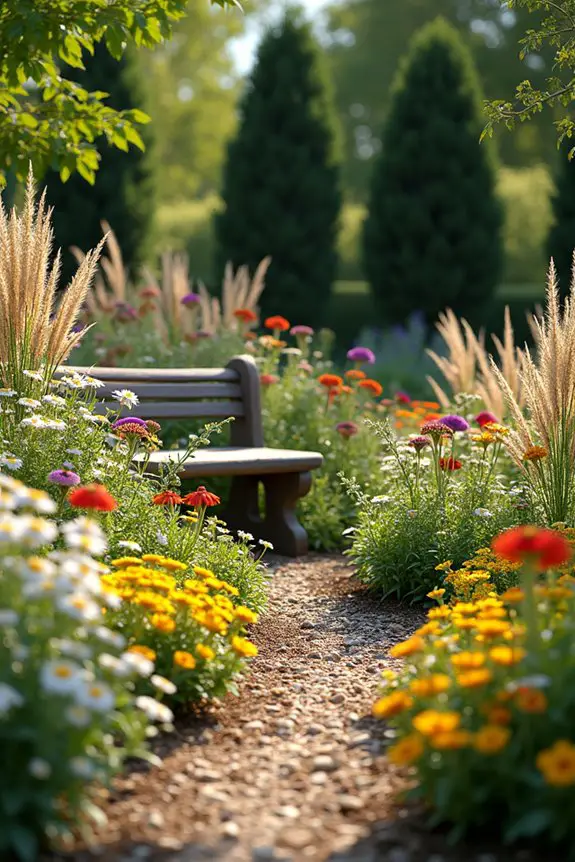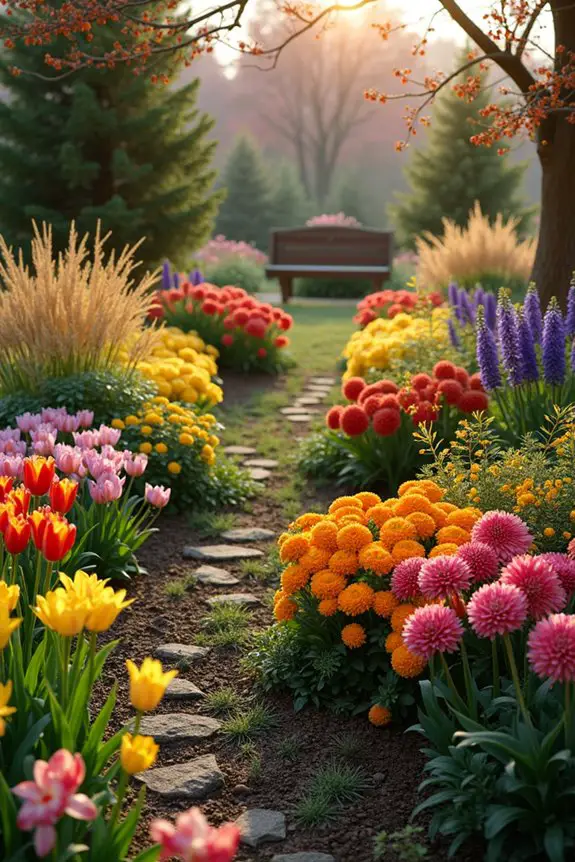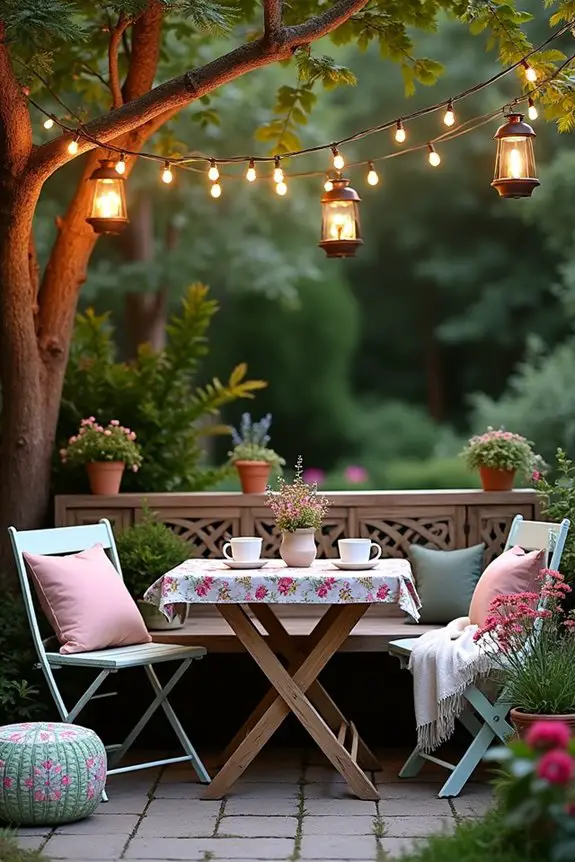Have you ever wondered if you can transform your garden without emptying your wallet? Well, you absolutely can. Imagine this: a vibrant space filled with colorful flowers, lush greens, and maybe even a vertical garden made from recycled materials. Sounds dreamy, right? But here’s the kicker – it doesn’t require a degree in landscaping or a fortune to pull off. Stick around, and let’s uncover some clever and budget-friendly DIY garden design ideas that’ll make your neighbors green with envy.
The Garden Layouts
Ready to transform your outdoor space?
Let’s talk about garden layouts that’ll make your neighbors peek over the fence in envy. From colorful containers to eye-catching pathways, you’ve got a treasure trove of ideas at your fingertips.
1. Colorful Container Gardening
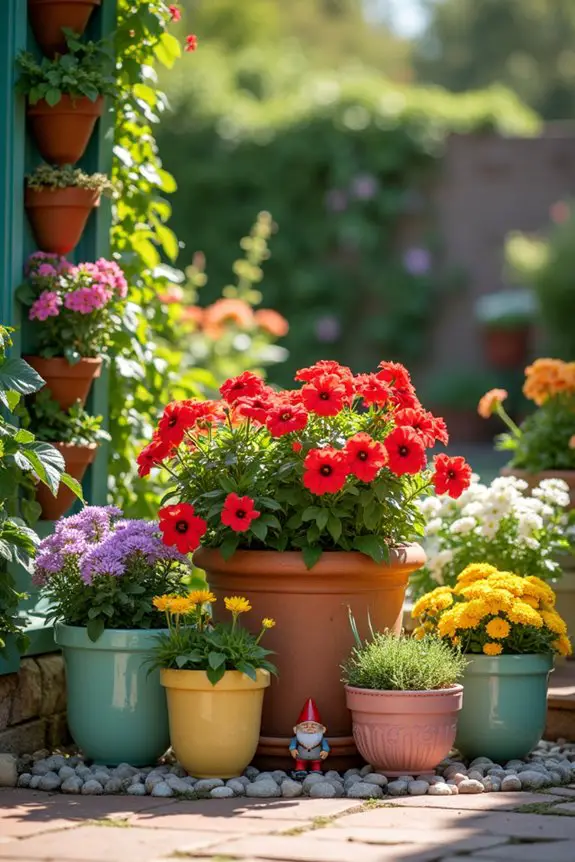
When it comes to colorful container gardening, the layout is everything. It’s not just about having plants; it’s about arranging them to create a lively vibe that draws the eye. Plus, functional design helps your plants thrive while making your space pop with color!
First, think about your containers. They come in all shapes and sizes—from terracotta pots to whimsical vintage cans. Mix and match to keep things interesting. A fun tip? Stick to a theme. Maybe you want a tropical vibe. In that case, grab vibrant, bold-colored pots and fill them with plants like bright hibiscus or cheerful petunias. Or maybe pastels are more your style; charming lavender and pale pink flowers in soft-colored pots can create a serene look. Classic garden gnomes can complement such themes beautifully by adding a touch of whimsy.
Next up, consider the height of your plants. Try to place taller plants in the back of a multi-tier arrangement or in the center if you’re using a circular layout—like a lively party! This way, everyone gets a good view of those beautiful blooms.
Also, let the shorter beauties dance in the front, creating a lovely layered effect. It’s like arranging a delightful bouquet, but with pots!
Don’t forget about foliage too. Mixing in lush green plants can provide contrast against those colorful blooms. It’s like a revitalizing sip of water after a rich dessert—satisfying in all the right ways. The vibrant greens can really make your colors stand out, so choose leaves with different textures for added interest.
And let’s be honest—sometimes less is more. Avoid overcrowding your containers. Stick to three or four different types of plants per pot for a balanced, harmonious look. Too many plants can lead to chaos, and who needs that when you can create a little slice of paradise?
Once you have your plants set up, tie everything together with some fun garden accessories. Cute garden gnomes, colorful stones, or even fairy lights can add that extra touch.
Adding a rotating vertical garden tower can help you maximize space and display your vibrant arrangements beautifully. Trust me, nothing gets your friends talking like a charming piece that tells a story.
2. Vertical Garden Techniques
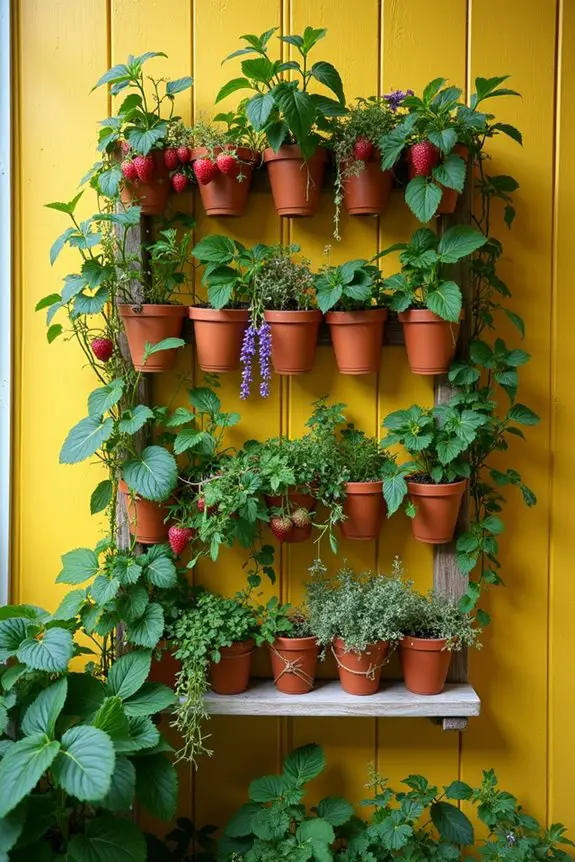
Vertical gardening is a delightful solution for those looking to maximize their gardening space while keeping things stylish and vibrant. It’s like creating a miniature green masterpiece that not only saves ground space but adds a dramatic flair to your garden, balcony, or even kitchen. Think of it as giving your plants a standing ovation, allowing them to shine while you save your precious planting real estate. You can also consider using macrame plant hangers to elevate the aesthetic appeal of your vertical garden.
To start, you’ll want some vertical structures—these can be trellises, wall planters, or even repurposed wooden pallets that you paint a cheerful color. Seriously, a bright lemon yellow or mint green backdrop can really make your plants pop. And don’t worry if you’re not a DIY expert; even a simple shelf can do the trick. Stack some cute pots with plants that like to go vertical—like climbing beans or cascading strawberries. Just picture it: delightful green tendrils winding their way up, like they’re climbing the ranks to become the stars of your garden.
Next, think about the spacing of your plants. It’s important not to cram them together like sardines in a can. Give them some breathing room, so their leaves can spread out and bask in the sunlight. Remember, too much competition for resources can lead to unhappy plants. You wouldn’t want to live in a crowded apartment, right?
Another handy tip is to choose a mix of plants with different textures and colors. Imagine vibrant flowers peeking through lush greenery, like a surprise party in a garden. Add in some herbs like basil or mint, and you’ll not only have a visual treat but a fragrant one too. Every time you walk by, you’ll feel like you’ve stepped into a little slice of paradise—no plane ticket required. Hanging planter baskets can also be a fantastic addition to your vertical garden to create a lush atmosphere.
Lastly, don’t forget your watering plan. Plants in vertical gardens might dry out quicker, especially if they’re hanging or stacked. A little routine will keep them happy and thriving. And hey, you can turn watering time into a zen ritual; just don’t get lost in thought and water a pot of fake flowers like I did once. Trust me, that was a sad moment, and the confetti from my imagination couldn’t make up for it.
3. Garden Bed Arrangement Ideas
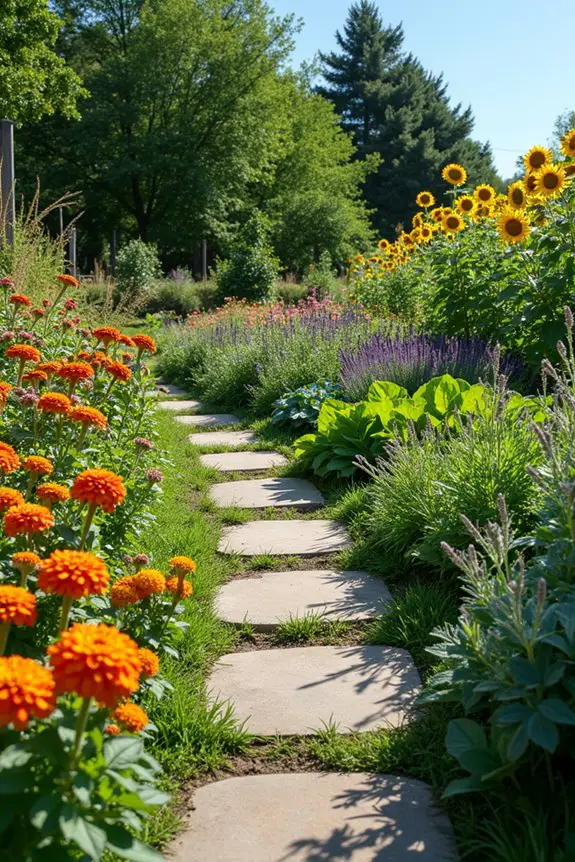
When it comes to arranging your garden beds, getting the layout just right can transform your outdoor space from mundane to magical. Imagine stepping outside, greeted by a beautiful tapestry of colors, textures, and heights that delight the senses. A thoughtful garden bed arrangement not only enhances the visual appeal but also optimizes plant health by considering sunlight, airflow, and maintenance access.
Start by zoning your garden. Think of it like planning a party: you wouldn’t want all your guests crowding in one corner. Separate areas for flowers, vegetables, and herbs can create an organized aesthetic and make it easier to tend to them. For instance, placing taller plants like sunflowers at the back of a bed guarantees they don’t overshadow shorter beauties like marigolds or pansies.
Next, consider shapes. Long, straight rows can feel a bit stiff and formal, like an army of plants standing at attention. Instead, try curving the edges or forming a gentle spiral. This not only promotes a relaxed vibe but makes wandering through your garden feel like an adventure.
Just be careful not to create a labyrinth; I once got lost in my own garden for an embarrassing 20 minutes—turns out, yelling “Help!” doesn’t attract the chipmunks.
Color coordination is another fun aspect to play with. Grouping plants of similar colors creates a harmonious look, while contrasting colors can make features pop. Think of it as creating a color palette on a canvas, where every shade has its role.
When my bright orange zinnias bloom next to deep violet salvia, it’s like they’re having a party that makes everyone else jealous. Additionally, using the right garden scissor set can help you maintain the beauty and health of your plants as you trim and shape them throughout the season.
Lastly, don’t forget to incorporate pathways for easy access. Just like a good recipe, a garden needs structure. Walkways not only guide the eye but provide space for you to care for your plants without trampling them.
Try using stones, mulch, or even stepping stones—just no more than an awkward hopscotch course, unless you’re aiming for a garden Olympics.
4. Pathway Patterns
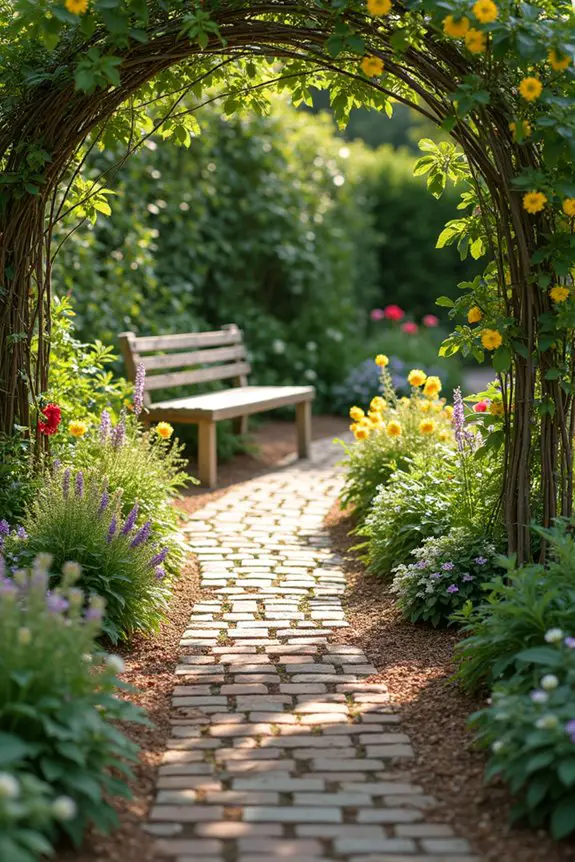
When it comes to creating pathways in your garden, think of them as the veins that carry beauty through your outdoor space. Not only do they guide visitors smoothly from one area to the next, but they also add structure and style. A well-designed pathway can transform the entire vibe of your garden, making it feel spacious, inviting, and even a little magical.
Now, let’s explore some fun pathway patterns you can try. First up are straight paths. These are like the dependable friends of the garden world—straightforward but reliable. They work well for formal gardens, leading the eye towards a special spot, maybe a birdbath or a cozy bench.
But, if you want to spice things up a bit, consider curves. A meandering path adds an element of surprise, beckoning you to explore what lies around the corner. Trust me, I’ve chased my dog through a winding path that felt like a mini adventure; who knew a trip to the garden could lead to a game of hide-and-seek?
Next, don’t shy away from geometric designs. Squares and rectangles can give a modern look, especially when framed with some vibrant flowers or low shrubs. You can even get creative with circles or spirals, creating a centerpiece that draws the eye.
Just be cautious if you opt for a spiral; I once got a bit too ambitious and created a dizzying loop. Let’s just say it took two cups of coffee to regain my sense of direction.
For materials, you have several options. Stone pavers add a classic touch, while gravel can offer a rustic feel—just watch your step. And wood chips? They’re comfortable for the feet but can leave you with little visitors (like ants).
Personally, I love using reclaimed bricks; they tell a story, and each one has its own character. Plus, if you mess up during installation, those charming irregularities can become part of the charm instead of a blunder.
Lastly, consider incorporating plants along your path. Low-growing flowers or groundcover plants can soften the edges, inviting you in for a closer look. Just make sure they won’t steal the show from the main plants—there’s nothing worse than a path that upstages your garden’s stars.
If only my pepper plants had the same attitude towards the squash—they always seem to take over the garden.
5. Focal Point Creation
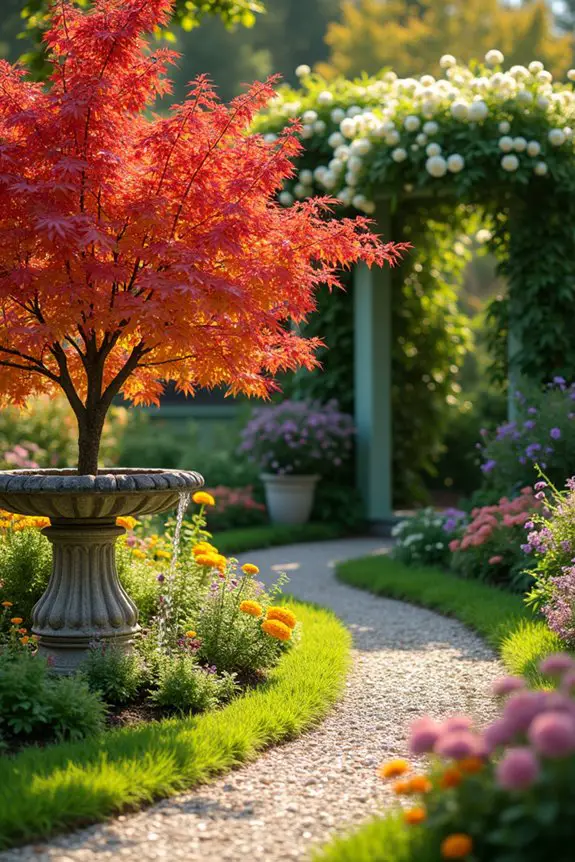
One great way to establish a focal point is by choosing a standout plant or flower, something that pops with color or unique texture. Think bright red dahlias or a stunning ornamental tree. I once planted a small Japanese maple in the center of my garden, and its fiery autumn leaves turned my backyard into a little slice of paradise. The moment visitors arrive, their eyes immediately gravitate towards it, creating a sense of warmth and welcome.
Another approach? Consider adding a decorative element such as a quaint birdbath or an eye-catching trellis with climbing vines. A trellis doesn’t just serve as an architectural feature, but it can also be a home for lush, fragrant plants. The combination of blooms and structure feels like art hanging in a gallery.
Just remember to anchor it well; I’ve had one tumble over in the wind, and let’s just say the flowers weren’t too happy about that.
Don’t forget about height—varying the levels of your focal points can create depth and dimension in your garden. A small raised bed or a wooden planter with cascading flowers can add layers of interest. I tried this once with a stacked planter, only to realize that ensuring it doesn’t topple over requires a bit of finesse.
Watching my neighbor’s cat try to explore it was both entertaining and a little nerve-wracking.
Lastly, think about the placement. Position your focal point at the end of a path or in a prominent spot where it can shine. You want it to draw people in, enticing them to come closer, explore, and soak in the beauty.
After all, a well-framed focal point can make even the busiest little gardens feel like an escape. It’s all about that magical feeling of discovery tucked within your own backyard.
6. Eco-friendly Material Selection
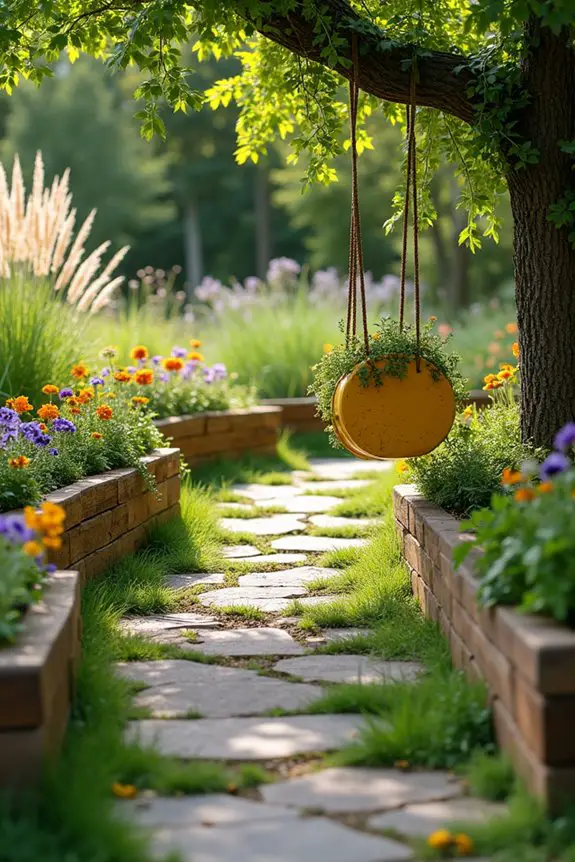
When it comes to designing your garden, choosing eco-friendly materials can really make a difference—not just for Mother Earth, but for the overall vibe of your space. Going green often means incorporating natural materials, which can give your garden a rustic, organic feel. Plus, it’s a great way to show off your commitment to sustainability. Who doesn’t want to be known as the “eco-friendly garden guru” on the block?
First off, consider using reclaimed wood for raised beds or pathways. Not only does this type of wood come with charming character and history, but it often has a lower environmental impact than newly harvested timber. Think of it as giving new life to something old—like that funky piece of furniture you can’t bear to toss.
I remember building my first raised bed out of reclaimed wood from an old barn. Honestly, it felt a bit like a mini-adventure, especially when I realized I probably should’ve used gloves. Let’s just say splinters weren’t my best accessory.
Stone is another fantastic option. Natural stones can create beautiful borders or pathways, lending an earthy texture that connects your garden to the surrounding landscape. Plus, they last forever, which is great if you’re someone like me who tends to move plants around on a whim—accidentally uprooting a flower bed and trying to remember where you left the stones can be a challenge.
Just think about that rustic charm—nothing says “serene retreat” quite like a winding path of stones leading to your favorite garden nook.
And, don’t overlook recycled materials for your garden décor. Old tire swings can transform into playful planters. When I first tried this, I painted it a bright yellow just to see if I could make something truly unloved, well, pretty.
DIY projects definitely bring out the creative juices, but there can be a learning curve—especially when the paint doesn’t dry as fast as you hoped, and your cat thinks it’s the perfect new scratching post.
Incorporating these eco-friendly materials isn’t just about saving the planet. It’s about creating a space that feels good to be in, somewhere you can relax and decompress after a long day.
7. Garden Theme Coordination
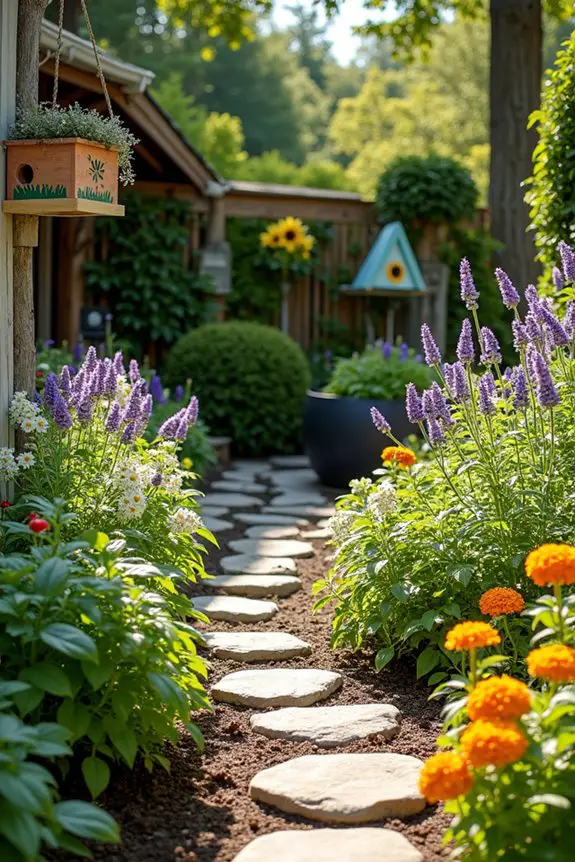
When you think about designing a garden, theme coordination is essential. It ties every element together, creating harmony and transforming your outdoor space into a cohesive visual retreat. Imagine stepping into a garden that feels curated rather than haphazard; it’s like walking into a well-decorated room that just grabs your heart. You want your garden layout to be both functional and inviting—a place where friends can gather and you can unwind with a good book.
Let’s explore a few fun themes you might consider. The cottage garden, for example, is dreamy with its relaxed mixture of flowers and veggies, leading to a charmingly informal vibe. Picture lilacs and daisies mingling with a tumbling tomato plant; it feels like nature’s very own patchwork quilt.
To create this look, aim for a layered layout where taller plants sit at the back, gradually giving way to shorter blooms and perhaps, a few herbs spilling over the edges. It can be like a botanical version of Mario Kart; you want layers and surprises around every corner, minus the banana peels, of course.
Or maybe you fancy something more modern? Featuring sleek lines and minimalism in your garden can really up your cool factor. Think geometric planters and structured hedges that almost look like nature’s artwork. It’s a clean look that whispers sophistication—perfect for those of us who live in a more urban setting and want to keep things fresh.
Start with a design that has defined areas: a zen corner, a fire pit, and maybe a chic dining area. Every space should have a purpose, much like that one drawer in your kitchen that actually sorted utensils, not just stuffed with random things. Remember: balance is key.
Lastly, don’t forget the touch of whimsy. Whether that’s a quirky birdhouse or a rainbow of colored pots, those little pops of personality can really make your space unique. It’s kind of like wearing socks with sandals; some might raise an eyebrow (and some might judge), but you know you’re being wonderfully you.
Plant your themes as though you’re telling a story through your garden. Every step should lead to something unexpected, something that makes you smile.
8. Seasonal Plant Selection
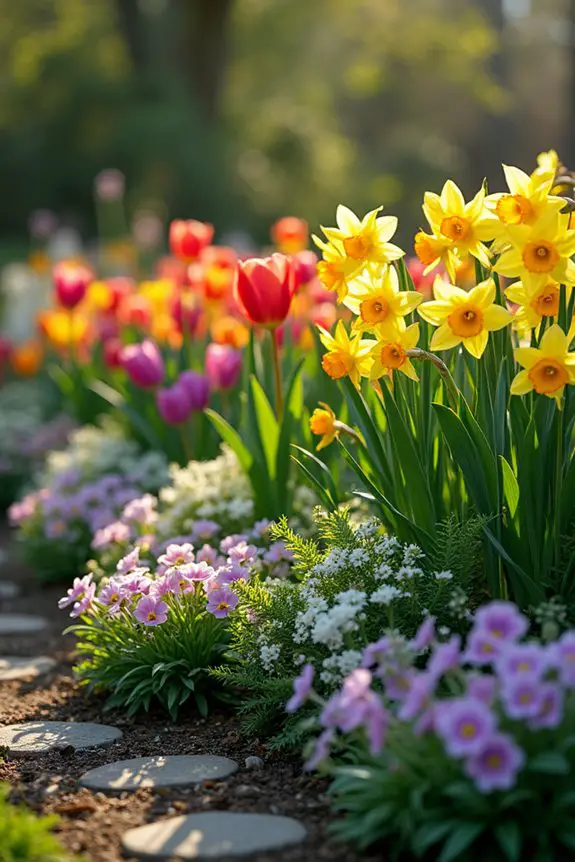
When it comes to seasonal plant selection, choosing the right flowers and greenery for your garden layout is a game changer. Not only does it create visual interest—just think of blooming colors changing with the seasons—but it’s also super functional. Picking plants that thrive during specific times of the year guarantees your garden is alive and happy, no matter when you step outside.
First things first, think about your climate. Are you in a cooler zone where spring bulbs reign supreme, or are you basking in the warmth with summer perennials? In cooler climates, try planting tulips and daffodils in the fall so they can surprise you with lovely blooms come spring. Meanwhile, if you’re riding the warmth wave, contemplate petunias and marigolds for summer—it’s like giving your garden a sun-kissed personality.
Once you’ve narrowed down your seasonal stars, it’s important to reflect on how they fit within your overall layout. For example, a spring garden layout might’ve taller daffodils at the back, softly evolving into vibrant tulips, and cascading pansies at the front. It’s the visual equivalent of a fun surprise party, with each plant bringing its own charm and personality to the floor.
And don’t forget about texture! Mixing in plants with different leaf shapes can really make your seasonal display pop. Think about the contrast between feathery ferns and bold, broad-leafed hostas. It’s like choosing different toppings on a pizza—sure, plain cheese is good, but who can resist a slice with a little crispy bacon and juicy pineapple?
If you’re feeling a bit overwhelmed, don’t fret. You can always start with a few core plants for each season and build from there. A little experimentation will help you find what works best, and before long, you’ll be the proud parent of a garden that switches its outfit as easily as you change your socks.
Just aim for a garden that feels alive and inviting at all times; after all, it’s your own little slice of nature, ready to bring joy throughout the year.
Happy planting, and may your garden be so bright that your neighbors need sunglasses just to look at it.
9. Design for Small Spaces
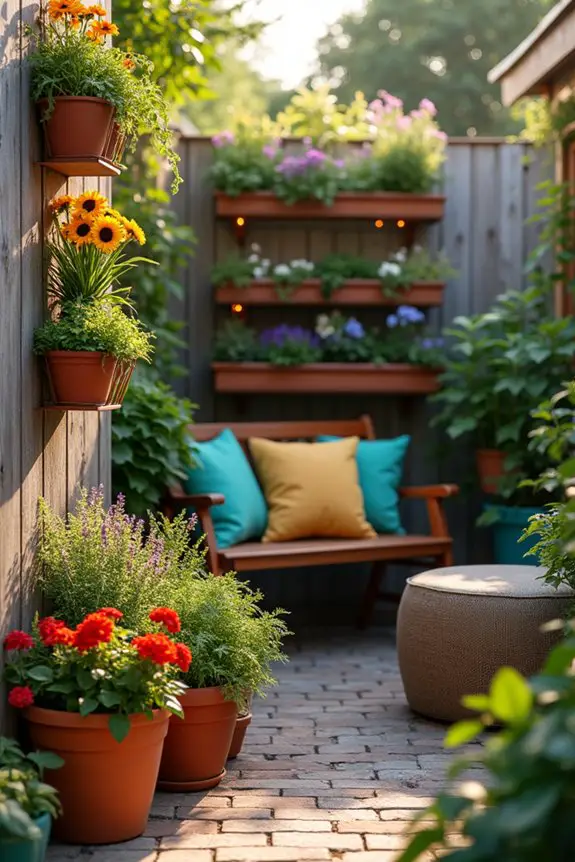
When you’re working with a small space, every inch counts, which can make your garden layout a fun puzzle. The beauty of compact design is that it allows for creativity and character in ways a large plot might not. Sure, you may feel like you’re fitting a giraffe into a phone booth, but who doesn’t love a good challenge?
One smart trick is to use vertical gardening techniques. Think of wall-mounted planters or tall shelving units adorned with trailing vines. Not only do these options save floor space, but they bring a lush, garden-feel to walls, giving off that dreamy “I’m basically living in an oasis” vibe. With herbs cascading down on your kitchen wall, your tiny corner could feel like a gourmet restaurant!
Consider layering your plants too. Start with the tallest plants in the back—like a proud sunflower standing tall amongst the rest—and gradually bring the shorter ones toward the front. This simple but chic approach helps guarantee every little green buddy gets its moment in the sunshine.
Imagine standing in your small patch of paradise and spotting every plant, like you’re the grand conductor of a vibrant botanical symphony.
And let’s not forget about the magic of container gardening! This lets you mix and match plants, swap them out based on the season, or just change things up if you’re feeling a little bored. Feel like a plant parent whose babies are always popping up in new places—who wouldn’t want to cultivate that spirit of adventure?
Finally, think about multi-functional furniture. Foldable benches or storage ottomans can transform from a seating area to a planter in the blink of an eye, making you feel like a gardening magician every time you entertain.
The goal here is to create a space that’s not just functional, but where you can sip your coffee, soak up the sun, and feel the warmth of your very own slice of nature right outside your door.
10. Design With Local Flora
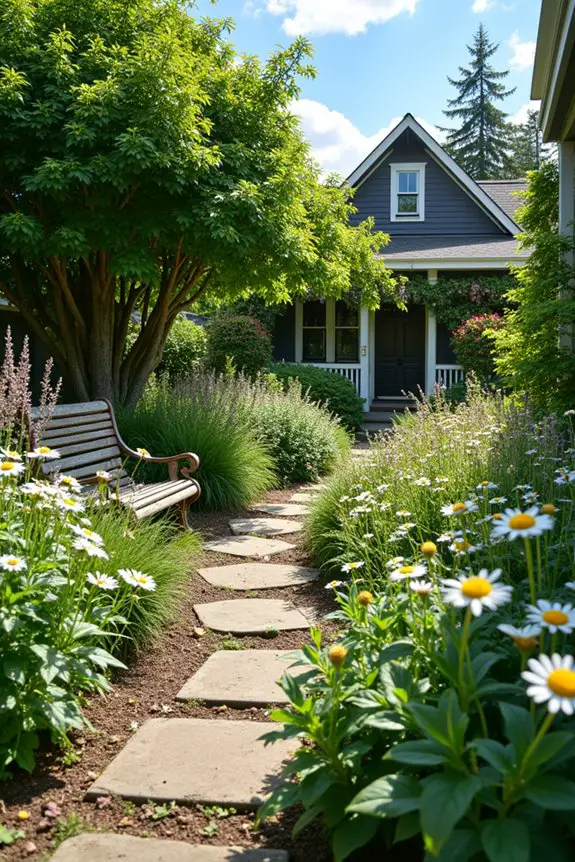
When designing your garden, incorporating local flora isn’t just smart—it’s downright charming. Using plants that thrive in your area means less fussing over care and more time soaking in the beauty. Plus, nothing beats the vibrant colors and textures of plants that are naturally in sync with your local climate and soil. Trust me, your garden will feel authentic and alive, breathing in the essence of your community.
To start, research what native plants grow in your region. Consider visiting a local nursery or even checking online resources to familiarize yourself with your choices. You might be surprised to find stunning wildflowers, ornamental grasses, or even hardy shrubs that add pizzazz without demanding endless attention. After all, who wants to spend countless hours babysitting their garden?
When planning your layout, think about planting in clusters. For instance, place a group of daisies together to create a splash of cheerful color, or mix in some native grasses to give a textured look that feels wild and free. It’s like arranging the perfect salad—different ingredients enhance one another while making the whole dish visually appetizing.
You want a layout that flows and feels cohesive, but also has a bit of that natural whimsy. Also, consider the arrangement based on your garden’s sun and shade patterns. Native plants often have their own preferences, so group the sun-lovers together and let the shade-seekers chill out in the cooler spots. You’ll be amazed at how much happier these plants will be when they’re in their happy place. It’s like finding the perfect seat at a coffee shop—everyone has their spot!
And don’t forget to think about the seasons. By incorporating a mix of plants that bloom at different times, you create year-round interest. A little planning can turn your garden into a living calendar, where each season brings new surprises. Plus, you’ll definitely earn some bragging rights when your friends come over and marvel at how it looks like Mother Nature herself styled your space.
In the end, designing with local flora means creating a garden that feels like home. As you dig, plant, and nurture, you’re also weaving a connection to your surroundings. So, grab those trowels, channel your inner botanist, and let your imagination bloom, one local plant at a time.
Budget-Friendly Tools Selection
Getting the right tools doesn’t have to break the bank. Seriously, you don’t need a fancy toolbox to implement your garden ideas DIY cheap style. Start with the basics: a sturdy trowel, a hand rake, and pruning shears. You’ll be amazed at how far these simple tools can go.
You don’t need expensive tools to garden; just grab a trowel, rake, and shears to get started!
Toss in some gloves, and you’re practically a professional—minus the hefty bill.
Check local thrift shops or garage sales for hidden gems; you might score a vintage wheelbarrow or a rusty but trusty hoe.
Don’t forget to ask friends for hand-me-downs too. Gardening can be fun and budget-friendly, plus who doesn’t love a good DIY challenge?

